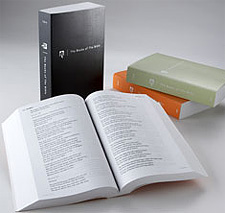This new product from The International Bible Society's Design Group is a great aid for Christians who want to better understand the Bible, and especially how it fits together. It removes chapters, verses and headings, reorders the books, and even puts back together again books of the Bible which later tradition divided. It is nice to have a Bible which looks like a book again, and not a reference manual or legal document.
The familiar book order goes back to 200 BC for the Septuagint (the Greek translation of the Old Testament), and around 400 AD for the New. But this format simply puts the Old Testament poetry and prophets and Paul's letters in descending order by size, giving the reader no idea of how they relate to one another, nor of their different genres.
 The 1189 chapters, which were added in 1205 AD and the 30,000 verses added around 1550 AD, often divide up the Word of God in an unhelpful way. They are a great aid to citing Scripture and to finding a particular sentence or phrase, but they do not encourage us to read the Bible as it was originally intended to be read.
The 1189 chapters, which were added in 1205 AD and the 30,000 verses added around 1550 AD, often divide up the Word of God in an unhelpful way. They are a great aid to citing Scripture and to finding a particular sentence or phrase, but they do not encourage us to read the Bible as it was originally intended to be read.
The reordering of the books in this new collection may not be obvious at first, because the renamed First Testament begins with the Torah and continues through in the order we are used to. But when you get to the books of Samuel and Kings you will discover that these four Former Prophets are now one continuous narrative. (Don't be concerned that you won't be able to find your place, because there are reference markers at the bottom of each page giving chapters and verses, and you can determine which part of Samuel-Kings you are in, because the current section is highlighted in bold print.)
The First Testament is in three sections, like the Hebrew Bible: Torah, Prophets, Writings, though this new arrangement is also ordered chronologically for the Prophets and by genre for the Writings. It is helpful to find, for example, Amos, Hosea, Micah and Isaiah, who prophesied in the 8th century BC during Assyria's ascendancy, grouped together. The Writings section has Psalms, Lamentations and Song of Songs, the three books of song lyrics placed side by side, followed by the three wisdom books, Proverbs, Ecclesiastes and Job. Chronicles-Ezra-Nehemiah have been restored to their original creation as one book, and the First Testament concludes with Esther and Daniel.
The New Testament has Luke-Acts first, restored to its original appearance as a two volume work of what Jesus began to do and teach (Luke) and then what he achieved after his resurrection through his apostles (Acts). Paul's connection with Luke leads to his letters coming next, arranged chronologically with 1 and 2 Thessalonians heading the list. Matthew appears side by side with the two other books clearly written to Jewish Christians, Hebrews and James, which are followed by Mark and his mentor Peter's letters and Jude, then John's gospel and letters and finally Revelation, ending apocalyptically as the First Testament had done with Daniel.
Each testament, section and Bible book comes with a short introduction and explanation of how it fits into the whole Bible. Although there are no headings, the designers have attempted to show how the writers indicated divisions in their books by the judicious use of paragraphing, indentation and spacing. It is suggested that this was originally shown by repetition of a phrase, change of topic, movement in place or time and by changing from one kind of writing to another.
This is one of the most helpful aspects of the new Bible. I particularly like how Ephesians 5:21-33 has been arranged, with Paul's instruction to Submit to one another out of reverence for Christ printed in a separate paragraph, and with indents in the following passage addressed to wives, husbands, children, fathers, slaves and masters showing that each one of these is an illustration of how we are to submit to one another.
The design of this Bible is a great aid to readability and an encouragement to read the Bible as a book and not as a series of independent, disconnected statements. Once I've found the location of the passage, I find it is easier to read aloud from in church. This still needs preparation, of course, but part of the job is done for you when the text is arranged in this more logical fashion.
I highly recommend The Books of the Bible as a second Bible which will assist you to understand the Bible's message and structure, complementing your current one. You will find that the TNIV usefully updates the 30 year old NIV, both by being written in the manner in which we speak in the 21st century, and with many little changes that have been recommended since the NIV was written.
Visit the Books of the Bible web site for more information.
















